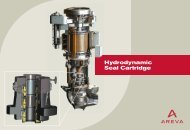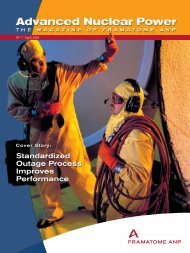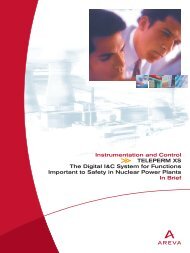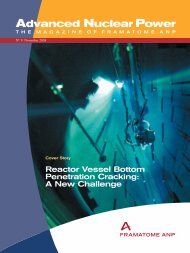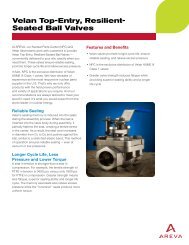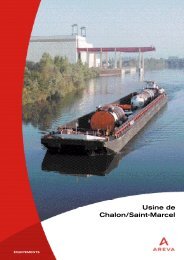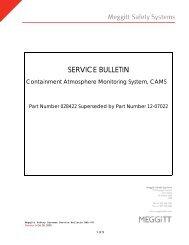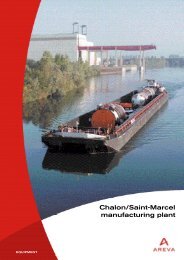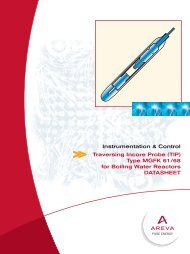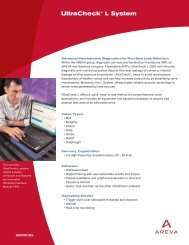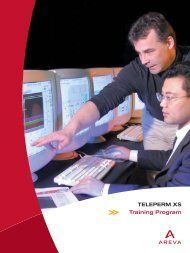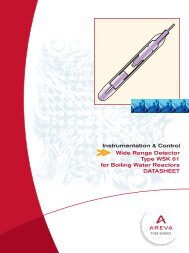EPR – Areva brochure
EPR – Areva brochure
EPR – Areva brochure
You also want an ePaper? Increase the reach of your titles
YUMPU automatically turns print PDFs into web optimized ePapers that Google loves.
FOREWORDThe <strong>EPR</strong>’s key assetsto support a strategic choiceAn evolutionary, safeand innovative designThe <strong>EPR</strong> is a 1,600 MWe class PWR. Its evolutionary designis based on experience from several thousand reactor - yearsof operation of Light Water Reactors worldwide, primarilythose incorporating the most recent technologies: the N4 andKONVOI reactors currently in operation in France andGermany respectively. The <strong>EPR</strong> design integrates the resultsof decades of research and development programs, in particularthose carried out by the CEA (French Atomic EnergyCommission) and the German Karlsruhe research center.Through its N4 and KONVOI filiation, the <strong>EPR</strong> totally benefitsfrom the uninterrupted evolutionary and innovationprocess which has continuously supported the developmentof the PWR since its introduction in the Western marketplacein the mid-fifties.Offering a significantly enhanced level of safety, the <strong>EPR</strong>features major innovations, especially in further preventing coremeltdown and mitigating its potential consequences. The<strong>EPR</strong> design also benefits from outstanding resistance toexternal hazards, including military or large commercial airplanecrash and earthquake. Together, the <strong>EPR</strong> operating andsafety systems provide progressive responses commensuratewith any abnormal occurrences.> Building on ExperienceEnhanced safety level and competitivenessThanks to a number of technological advances, the <strong>EPR</strong> isat the forefront of nuclear power plants design. Significantprogress has been incorporated into its main features:• the reactor core and its flexibility in terms of fuel management,• the reactor protection system,• the instrumentation and control (I & C) system, the operatorfriendly man-machine interface and fully computerizedcontrol room of the plant,• the large components such as the reactor pressure vesseland its internal structures, steam generators and primarycoolant pumps.These innovations contribute to the high level of performance,efficiency, operability and therefore economic competitivenessoffered by the <strong>EPR</strong> to fully satisfy customers’expectations for their future nuclear power plants.The straightforward answer to utilities’ andsafety authorities’ requirements for newnuclear power plantsThe French-German cooperation set up to develop the <strong>EPR</strong>brought together, from the start of the project:• power plant vendors, Framatome and Siemens KWU(whose nuclear activities have since been merged to formFramatome ANP, now an AREVA and Siemens company),• EDF (Electricité de France), and the major German utilitiesnow merged to become E.ON, EnBW and RWE Power,• the safety authorities from both countries to harmonizesafety regulations.The <strong>EPR</strong> design takes into account the expectations of utilitiesas stated by the “European Utility Requirements” (EUR)and the “Utility Requirements Document” (URD) issued bythe US Electric Power Research Institute (<strong>EPR</strong>I). It complieswith the recommendations (1993) and positions onmajor issues (1995) that the French and German safetyauthorities jointly set up. The technical guidelines covering the<strong>EPR</strong> design were validated in October 2000 by the Frenchstanding group of experts in charge of reactor safety (“GroupePermanent Réacteurs” which is the advisory committee forreactor safety to the French safety authority) supported byGerman experts.On September 28, 2004, the French safety authority, onbehalf of the French government, officially stated that the<strong>EPR</strong> safety options comply with the safety enhancementobjectives established for new nuclear reactors.Continuity in technologyThe N4 and KONVOI reactors are children of the earlierFramatome and Siemens KWU generation reactors whichare themselves derivative of standard US type PWRs, firstimplemented in the US, then refined and expanded uponby Framatome and Siemens KWU. The <strong>EPR</strong> is the directdescendant of the well proven N4 and KONVOI reactors,guaranteeing a fully mastered technology. As a result, riskslinked to design, licensing, construction and operation ofthe <strong>EPR</strong> are minimized, providing a unique certainty to <strong>EPR</strong>customers.Operator expertise acquired through the operation of nuclearpower plants using the same technology as the <strong>EPR</strong> is maintainedand its value is increased.Another major advantage is that the existing industrialcapacities for design, engineering, equipment manufacturing,nuclear power plant construction and maintenance<strong>–</strong> including capacities resulting from previous technologytransfers <strong>–</strong> can be easily deployed and utilized to carry outnew nuclear plant projects based on <strong>EPR</strong> technology.Enhanced economic competitivenessThe next generation of nuclear power plants will have to beeven more competitive to successfully cope with deregulatedelectricity markets.Thanks to an early focus on economic competitiveness duringits design process, the <strong>EPR</strong> offers significantly reducedpower generation costs. They are estimated to be 10%lower than those of the most modern nuclear units currentlyin operation, and more than 20% less than those of thelargest high-efficiency advanced combined-cycle gas plantscurrently under development (taking into account a gas pricein the US$* 3.5 per MBtu range). The advantage over fossilplants is even more pronounced when the “external costs”(such as costs related to the damage to environment andhuman health) are taken into account.* In 2001 US$.This high level of competitiveness is achieved through:† a unit power in the 1,600 MWe range(the highest unit power to date), providingan attractive cost of the installed kWe,† a 36-37% overall efficiency dependingon site conditions (presently the highestvalue ever for water reactors),† a shortened construction time relying onexperience feedback and continuousimprovement of construction methodologyand tasks sequencing,† a design for a 60-year service life,† an enhanced and more flexible fuel utilization,† an availability factor up to 92%, on average,during the entire service lifeof the plant, obtained through long irradiationcycles, shorter refueling outages andin-operation maintenance.Significant advancesfor sustainable developmentThe <strong>EPR</strong>, due to its optimized core design and higher overallefficiency compared to the reactors in operation today,also offers many significant advantages in favor of sustainabledevelopment, typically:N4Evolutionarydevelopmentkeeps referencesSolid basis of experiencewith outstanding performanceKONVOI† The <strong>EPR</strong> relies on a sound and proventechnology.† It complies with safety authoritiesrequirements for new nuclear plants.† Design and licensing, constructionand commissioning, operability and maintainabilityof <strong>EPR</strong> units benefit from FramatomeANP long lasting and worldwide experienceand expertise. Therefore, <strong>EPR</strong> customersuniquely minimize their technical risks andassociated financial impacts.• 17% saving on Uranium consumption perproduced MWh,• 15% reduction on long-lived actinidesgeneration per MWh,• 14% gain on the “electricity generation”versus “thermal release” ratio (comparedto 1,000 MWe-class reactors),• great flexibility to use MOX (mixedUO 2 -PuO 2 ) fuel.02 II 03



